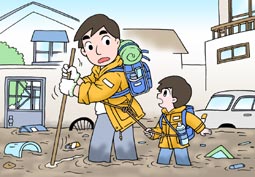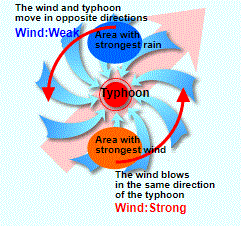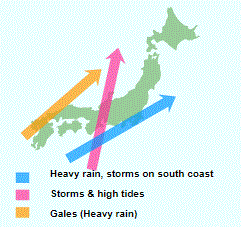Disaster Prevention Resources
Flood Preparedness
Previous flood information is here |
Be careful during typhoon season!
|
When heavy rain falls in the river region, or when snowfall in the mountains melts in the spring, a large amount of water flows into rivers, causing flooding. This may cause damage to the coastal protection barriers and the water that overflows the embankments may cause damage to the areas near the river’s shore.
|
Slightly heavy rain
10–20mm
|
|
It is difficult to have a conversation or to hear people speaking because of the sound of rain.
Rain forms puddles.
Beware if this level of rain continues for a long time.
|
|
|
Gutters overflow, small rivers flood, and small-scale landslides occur.
|
|
|
Significant downpour "Raining buckets".
Roads are flooded and look like rivers.
Landslides are more likely to occur.
Residents need to be ready to evacuate.
|
|
|
The rain is like a waterfall, making loud noise.
Water bursts from utility holes, and floods into basements and underground shopping malls. Many floods and flood-related disasters occur.
|
Dangerous rain levels
80mm and over |
|
The rain causes a feeling of suffocation, and people feel threatened.
A state of serious alert is required as there is a likelihood of a large-scale disaster occurring.
|
The impact of a typhoon changes with the direction in which it moves.
|
Upon receiving information on the expected course of a typhoon, check which side of your area it will pass.
|
|
Typhoon and wind directions
|
Warnings related to the course of a typhoon in Mie
|
 The wind and typhoon
The wind and typhoon
move in opposite directions
Wind:Weak
Area with
strongest rain
Typhoon
Area with
strongest wind
The wind blows
in the same direction
of the typhoon
Wind:Strong
|
|
 Heavy rain, storms on south coast
Storms & high tides
Gales (Heavy rain)
Heavy rain, storms on south coast
Storms & high tides
Gales (Heavy rain)
|
|
 |
When evacuating during floods, keep close watch of what is on the ground, help children and the elderly and keep close watch of them so that everyone can evacuate safely.
|
 |
 |
 |
 |
 |
-
Do not walk bare foot or in boots. It is better to wearing sneakers with shoelaces.
-
When walking in water, use a long stick for stability and also to search under the water.
-
Lead elderly and sick people by the hand or carry them on your back.
-
Give flotation devices to infants and the elderly.
|
 |
 |
 |
 |
 |
 |
|
Previous flood information is here |
Be careful during typhoon season! |
When heavy rain falls in the river region, or when snowfall in the mountains melts in the spring, a large amount of water flows into rivers, causing flooding. This may cause damage to the coastal protection barriers and the water that overflows the embankments may cause damage to the areas near the river’s shore.
|
Slightly heavy rain
10–20mm |
|
It is difficult to have a conversation or to hear people speaking because of the sound of rain.
Rain forms puddles.
Beware if this level of rain continues for a long time.
|
|
Gutters overflow, small rivers flood, and small-scale landslides occur. |
|
Significant downpour "Raining buckets".
Roads are flooded and look like rivers.
Landslides are more likely to occur.
Residents need to be ready to evacuate. |
|
The rain is like a waterfall, making loud noise.
Water bursts from utility holes, and floods into basements and underground shopping malls. Many floods and flood-related disasters occur.
|
Dangerous rain levels
80mm and over |
|
The rain causes a feeling of suffocation, and people feel threatened.
A state of serious alert is required as there is a likelihood of a large-scale disaster occurring. |
The impact of a typhoon changes with the direction in which it moves. |
Upon receiving information on the expected course of a typhoon, check which side of your area it will pass. |
| Typhoon and wind directions |
Warnings related to the course of a typhoon in Mie |
 |
 |
When evacuating during floods, keep close watch of what is on the ground, help children and the elderly and keep close watch of them so that everyone can evacuate safely.
|
 |
 |
 |
 |
 |
 |
- Do not walk bare foot or in boots. It is better to wearing sneakers with shoelaces.
- When walking in water, use a long stick for stability and also to search under the water.
- Lead elderly and sick people by the hand or carry them on your back.
- Give flotation devices to infants and the elderly.
|
 |
 |
 |
 |
 |
 |
|
Copyright(C) Mie Prefecture, All Rights Reserved.
Department of Disaster Prevention, Mie Prefecture













